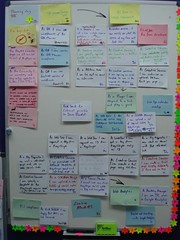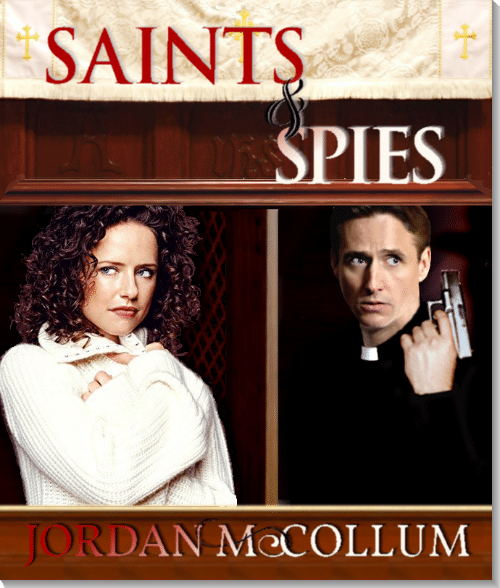Trying to “fix” a Winchester Mystery Story to make a habitable home novel wasn’t the only reason I turned to plotting. My next project came about from off-the-wall speculation with Sarah, one of my writing friends from high school. (Off-the-wall speculation is our specialty.)
 One day, our crazy speculation turned to international soaps we watched as teenagers—Abrázame muy fuerte (Mexican telenovela) and Ballykissangel (Irish soap opera). Although the soaps were really different from one another, they were both set in Roman Catholic cultures, and featured priests characters prominently. We felt really compelled to explore this fascination in fiction, and we wanted to write something together.
One day, our crazy speculation turned to international soaps we watched as teenagers—Abrázame muy fuerte (Mexican telenovela) and Ballykissangel (Irish soap opera). Although the soaps were really different from one another, they were both set in Roman Catholic cultures, and featured priests characters prominently. We felt really compelled to explore this fascination in fiction, and we wanted to write something together.
The day after this conversation, I sent her an email:
Okay, this idea is just crazy and a product of watching too many fabulous spy shows, BUT–what if he was joining the priesthood as a spy cover/to escape a horrible secret?
And she did me one better:
I LIKE IT! So now I have an even crazier idea.
I was thinking, maybe we could turn this story into that LDS themed book. Maybe we can have two couples? One LDS guy turns into a Catholic priest as a cover-up that he’s a spy. His friends and family won’t know and they’ll be totally shocked by it. What if he started flirting with this Catholic girl who really likes him but is disturbed by it (plagued with guilt) because she thinks he’s a real priest? So maybe guy A’s sister ends up moving to X-town where her brother lives and meets a real initiate (haha what do you call future priests?) and falls in love. [. . .]
Too crazy?
There are several seminaries in Chicago. Maybe “priest” A is posing as a Priest to get in with the mafia somehow?
You know, when you put it like that, it sounds absolutely insane . . .
My favorite kind of book!
So we set about our parallel novels, mine about the spy/priest and secretary/parishioner, and hers about the sister and the seminarian. To keep the projects straight, of course, we couldn’t both just pants our way through these novels. So I didn’t just dip my toes in the plotting pool. I jumped in the deep end:

- I wrote out full plot treatment, about one page long, hitting the milestones of the Hero’s Journey.
- I wrote a journal entry from the villain’s POV to understand his motivation behind the murder.
- I made a day-by-day timeline in a spreadsheet, her events in one column, mine in another.
That might sound like a lot of work. The first two were done the day after our emails, and we traded first chapters in the first two days after that. Most of all, however, we had fun. We didn’t shy away from the absurd, we put our characters into horrible straights, and we laughed and laughed and laughed.
The best parts were the scenes with all our characters in them. We would schedule times to “get together” online and write the dialogue/blocking in a spreadsheet (often with our own running commentary in another column…). Once we had them roughed in, we’d convert those scenes to prose with our characters’ thoughts.
The whole time, I feared the project was too “controversial” for an actual publisher to be interested. My previous projects were not going to get into publishable shape any time soon (or, likely, ever). Could I afford a third “flop” if I really wanted to be a published author?
In the end, though, I loved the story too much to let my perception of the market stop us. So we wrote and enjoyed our story. Within three months, we had two finished first drafts.
But, as any one knows who’s written “The End” enough times, that’s only the beginning. And in this case, the journey was a lot longer than it probably should’ve been. I had a lot to learn.
What do you think? Have you ever tried parallel novels or another form of co-authoring? How would you handle it?
Photo credits: trust your crazy ideas—Leandro Agrò; planning—Jez Nicholson


 Zach took a deep breath of the musty air of the small church. It was nothing like the chapels he was used to, of course, but he had act like this was his new home.
Zach took a deep breath of the musty air of the small church. It was nothing like the chapels he was used to, of course, but he had act like this was his new home. Well, St. Patrick is a pivotal figure in Irish Catholic history, but not a whole lot is known for certain about him. He was a Briton taken into slavery in Ireland, escaped after six years and returned to Britain, then entered the Catholic church and returned to Ireland. He is the most famous of three patron saints of Ireland (although technically he’s never been canonized by a pope). Legend says he banished snakes from Ireland and used the shamrock to teach the concept of the Trinity.
Well, St. Patrick is a pivotal figure in Irish Catholic history, but not a whole lot is known for certain about him. He was a Briton taken into slavery in Ireland, escaped after six years and returned to Britain, then entered the Catholic church and returned to Ireland. He is the most famous of three patron saints of Ireland (although technically he’s never been canonized by a pope). Legend says he banished snakes from Ireland and used the shamrock to teach the concept of the Trinity. Your knees, yes. Your Irish heritage, not so much. In Ireland, you’re most likely to see kilts on pipers. Really, the kilt is a Scottish tradition (and even then, the length of that tradition is disputed). Although there has been a bit of a movement to adopt it as Gaelic national dress (and what have you), the Irish kilt is mostly a phenomenon celebrated outside of Ireland.
Your knees, yes. Your Irish heritage, not so much. In Ireland, you’re most likely to see kilts on pipers. Really, the kilt is a Scottish tradition (and even then, the length of that tradition is disputed). Although there has been a bit of a movement to adopt it as Gaelic national dress (and what have you), the Irish kilt is mostly a phenomenon celebrated outside of Ireland.  But now I have another problem: it’s right around 101,000 words. In seven or eight rounds of revisions, I’ve added 12,000 words. So my next goal is to trim it back to 95,000 words, max.
But now I have another problem: it’s right around 101,000 words. In seven or eight rounds of revisions, I’ve added 12,000 words. So my next goal is to trim it back to 95,000 words, max. . I’m surprised that I’m still having ideas on this book, since I finished drafting so long ago (or it feels like it’s been so long). I’m starting to wonder if it’ll ever be “finished,” or, like George Lucas said (quoting someone else), it’ll be abandoned, never finished.
. I’m surprised that I’m still having ideas on this book, since I finished drafting so long ago (or it feels like it’s been so long). I’m starting to wonder if it’ll ever be “finished,” or, like George Lucas said (quoting someone else), it’ll be abandoned, never finished.